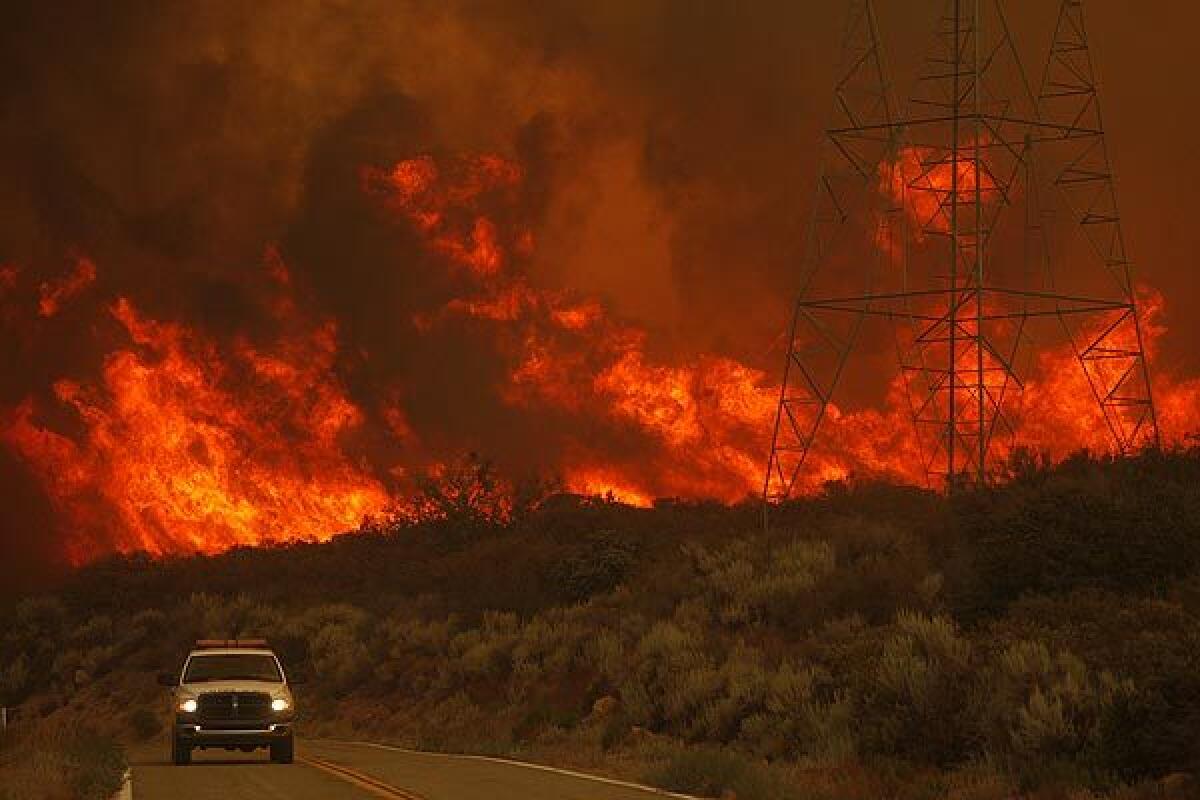Before the Station fire, a cost-cutting memo

Three weeks before the deadly Station fire erupted, the U.S. Forest Service issued a cost-cutting order to reduce its use of state and local firefighters, documents and interviews show.
Reinforcements from Los Angeles County were scaled back early in the battle against the fire in the Angeles National Forest, and federal officials now say they are investigating the actions that allowed the blaze to rage out of control.
An internal memorandum obtained by The Times instructed forest supervisors in the Pacific Southwest region to, “as appropriate,” replace non-federal crews with the service’s own personnel and equipment “as quickly as possible.”
The Forest Service reimburses other agencies for joining a firefighting operation on federal land.
The memo raises new questions about how the Forest Service handled the initial assault on the Station fire, especially after county ground crews and helicopters had helped keep the flames to 15 acres on Day One.
Forest Service officials have denied that cost concerns led them to deploy fewer crews and helicopters from Los Angeles County on the second morning of the fire, hours before it began to grow rapidly.
On Thursday, the No. 2 official in the Forest Service’s Washington, D.C., headquarters, Associate Chief Hank Kashdan, said the Aug. 5 memo should have had “nothing to do with our approach to suppressing a large fire, or a fire that’s going at any present time.”
Kashdan nevertheless said a Forest Service investigation of the attack on the Station blaze would examine whether budget worries had influenced the judgment of those deploying firefighters and equipment.
“It’s fair to everybody to let that investigation run its course and see what the review finds,” he said.
The memo from Regional Forester Randy Moore to forest supervisors warns that looming budget shortfalls require that “fire resources be managed to ensure no deficits.” It called for minimizing overtime expenses and equipment purchases, in addition to limiting the use of other agencies and contractors.
The Forest Service requested smaller numbers of county aircraft and firefighters for the next morning, when the flames started to spread.
“I’m in shock,” said Adi Ell-Ad, who lost his Big Tujunga Canyon home. “It would be a shame if stuff like that memo influenced the response to the fire.”
Bronwen Aker, a Big Tujunga resident who has set up a website for victims, said: “If their main concern was balancing the budget instead of saving homes, there’s something wrong with those priorities.”
The suspected arson fire, which broke out Aug. 26, destroyed about 90 homes and other structures, blackened more than 160,500 acres of the forest and killed two firefighters whose truck plunged off a mountain road. It is the biggest fire in the county’s history, and the estimated cost of fighting it is approaching $100 million.
The Times reported this week that the Forest Service prepared to go into mop-up mode the morning after the fire began, with fewer ground crews and helicopters, according to documents and interviews.
After the report was published, fire victims demanded an investigation, and the Forest Service launched its inquiry.
The county department responded to the fire automatically on the first day because the flames were close to communities such as La Canada Flintridge. Once it became clear the fire was within federal territory, the Forest Service took command and the county had to wait on the second day for federal officials to request personnel and equipment.
The Forest Service asked for two county helicopters on the second day, but the department sent only one, a large tanker. County Chief Deputy John Tripp has said he withheld the smaller chopper because he did not believe the fire threatened neighborhoods, and because he must keep some helicopters on standby for other emergencies.
That decision also has been criticized by people who lost homes.
Angeles Forest Fire Chief David Conklin has said that he ordered enough reinforcements on the second day, without regard to cost, but that the flames simply had moved too fast.
Because of the deaths, the county Sheriff’s Department is investigating the fire as a homicide.
The Forest Service has cited that investigation in declining to release more detailed information about its response to the blaze.
But elected officials have said the Forest Service should be more forthcoming about its tactics, unless such information could compromise the criminal probe.
“There is a distinction between a homicide investigation and how a fire is managed,” said Lindsey Mask, spokeswoman for Rep. Howard “Buck” McKeon (R-Santa Clarita), whose district includes part of the forest. “What resources were used in managing the fire needs to be transparent.”
--
paul.pringle@latimes.com
More to Read
Sign up for Essential California
The most important California stories and recommendations in your inbox every morning.
You may occasionally receive promotional content from the Los Angeles Times.










